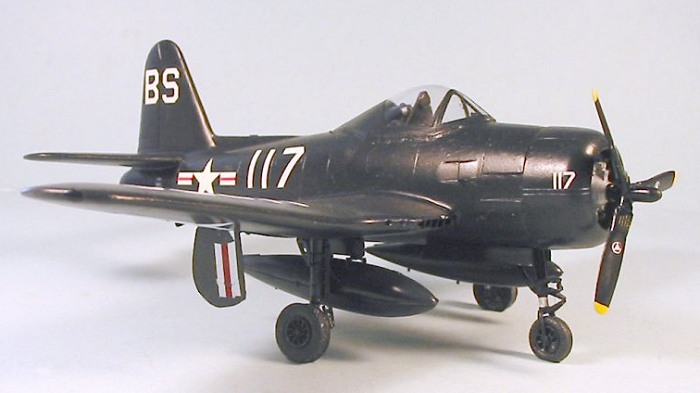
Czech Model 1/48 FR-1 'Fireball'
| KIT #: | 4815 |
| PRICE: | $39.95 (35.96 at Squadron) |
| DECALS: | 2 options |
| REVIEWER: | Tom Cleaver |
| NOTES: | Short run with vac canopy and resin parts |

| HISTORY |
Ryan Aircraft may have been one of the smaller companies, but it was justly famous for having designed and built the “Spirit of St. Louis,” and a number of other excellent designs. During the Second World War, the company’s PT-23 primary trainer was responsible for putting thousands of American pilots into the air.
Claude T. Ryan stayed
abreast of the latest developments in aviation, looking for a niche his
company could fulfill. He realized that jet propulsion would be
important, and looked for a way he could bring his company into the
field. During 1942,
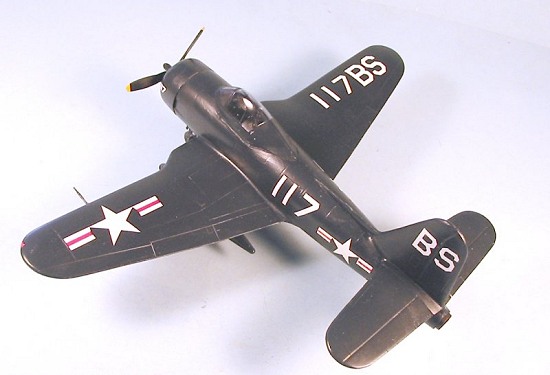 the Navy became aware of the enhanced performance
possible with jet powered aircraft, though they did not see a way to
adapt the jet - with its slow throttle response - to the requirements for
carrier operation. At the same time, the Navy was also made aware of the
need for a fleet interceptor with a high rate of climb, an airplane that
could remain aboard until the enemy strikes were engaged, then take off
to shoot down those raiders that broke through the combat air patrol.
the Navy became aware of the enhanced performance
possible with jet powered aircraft, though they did not see a way to
adapt the jet - with its slow throttle response - to the requirements for
carrier operation. At the same time, the Navy was also made aware of the
need for a fleet interceptor with a high rate of climb, an airplane that
could remain aboard until the enemy strikes were engaged, then take off
to shoot down those raiders that broke through the combat air patrol.
In December 1942, Ryan proposed an interceptor to the Navy that would combine both piston engine and jet engine, with the piston engine allowing for normal carrier operation, while the jet engine could enhance performance as an interceptor. The Navy responded favorably, with an order for three XFR-1 prototypes on February 11, 1943. This was followed by a production order for 100 FR-1s on December 2, 1943.
The first prototype flew on June 25, 1944, powered only by a Wright R-1820-56 Cyclone. The General Electric I-16 - modified to run on aviation gasoline rather than kerosene - which provided 1,600 pounds of static thrust, was mounted in the prototype that fall. With both piston and jet power, the aircraft had a top speed of 404 m.p.h. at 17,000 feet. While this was not as fast as the F4U Corsair, the XFR-1 had a rate of climb 50 percent faster than the Corsair.
By the fall of 1944, with the introduction of the kamikaze attacks, the need for a fist-climbing interceptor became a top priority for the Navy. When the first production FR-1s appeared in January 1945, the production order was increased to 1,200 aircraft.
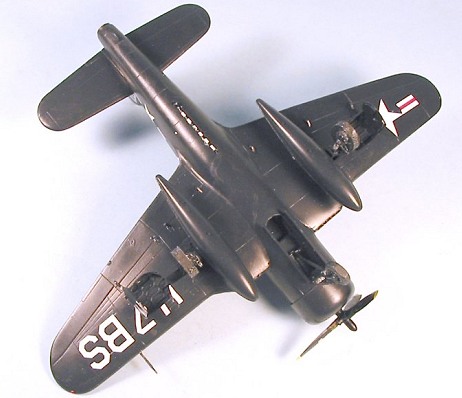 By the conclusion of the
war in August, 1945, only 66 FR-1s had been delivered. The rest were
canceled with the end of the war. At the time, one Navy fighter
squadron, VF-66, was close to achieving initial operational capability.
These aircraft, based at the Tustin Naval Air Station in Southern
California, had been responsible for a number of reports from pilots of
Hellcats and Corsairs and Mustangs regarding a strange airplane that
would fly past them with its propeller completely stopped - an
aerodynamic impossibility. The pilots of VF-66 had discovered it was
easy to stop and start both engines in flight, and had a great deal of
fun mystifying their fellow aviators. Three FR-1s gave the public a
display of this capability when they made a low pass over the Santa Anita
Race Track on opening day of race season in 1945, which was one of the
first public displays of jet-powered flight in the country.
By the conclusion of the
war in August, 1945, only 66 FR-1s had been delivered. The rest were
canceled with the end of the war. At the time, one Navy fighter
squadron, VF-66, was close to achieving initial operational capability.
These aircraft, based at the Tustin Naval Air Station in Southern
California, had been responsible for a number of reports from pilots of
Hellcats and Corsairs and Mustangs regarding a strange airplane that
would fly past them with its propeller completely stopped - an
aerodynamic impossibility. The pilots of VF-66 had discovered it was
easy to stop and start both engines in flight, and had a great deal of
fun mystifying their fellow aviators. Three FR-1s gave the public a
display of this capability when they made a low pass over the Santa Anita
Race Track on opening day of race season in 1945, which was one of the
first public displays of jet-powered flight in the country.
With its jet engine and tricycle landing gear, the FR-1 gave the Navy the opportunity to begin developing procedures for handling jet aircraft at sea, which was of great use as the FH-1 Phantom and FJ-1 Fury entered fleet service in the immediate postwar years. The FR-1 left first line service in 1947.
So far as I know, there is only one FR-1 “Fireball” left still in existence, that being the one out at the Planes of Fame Air Museum in Chino. The airplane was acquired by Ed Maloney in the late 1950s, and sat nearly derelict out behind the museum’s single hangar for a good 20 years, protected only by its paint, before being taken into the Jets Museum building in the 1980s. Now that Planes of Fame is in the process of restoring the YP-59A to flight status using I-16s that were rebuilt by General Electric, the FR-1 has moved into restoration to flight status. The airframe is basically sound, and at present is being repainted while a new canopy is being built for it. It may fly as soon as next year on piston power only, while its original I-16 is now being rebuilt for flight status by General Electric for the Museum.
| THE KIT |
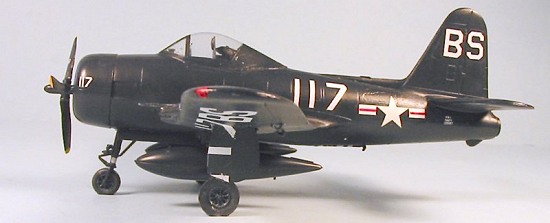 Unless there is some
obscure vacuform of the FR-1 that I am unaware of, this kit by Czech
Master is the first 1/48 kit of the Fireball, and follows Squadron Shop
policy of creating models of interesting experimental and limited
production aircraft of the World War II period, such as the XP-55
Ascender, XP-56 Black Bullet and FJ-1 Fury.
Unless there is some
obscure vacuform of the FR-1 that I am unaware of, this kit by Czech
Master is the first 1/48 kit of the Fireball, and follows Squadron Shop
policy of creating models of interesting experimental and limited
production aircraft of the World War II period, such as the XP-55
Ascender, XP-56 Black Bullet and FJ-1 Fury.
The kit is primarily limited-run injection-molded plastic, with a resin cockpit, engine and wheel wells, and two vacuformed canopies. Decals are provided for two aircraft from VF-66 and VF-1E. For a look at what comes in the box, please visit the preview.
| CONSTRUCTION |
This is one of the better kits in this line, and the improved production quality of the parts is reflected in the relative ease of construction.
I first cleaned up all the main resin parts and knocked off the mold-release towers on the plastic parts. I then painted and assembled the cockpit, then set it aside while I assembled the wings and tail surfaces. I finished by assembling the fuselage.
 The really obvious problem of the kit was to make it a nose-sitter,
since there was so much kit aft of the main gear. I started by
flattening as many fishweights as possible and cramming them as far
forward in the fuselage as possible, test fitting the cockpit and nose
wheel well until I had filled that space as much as I could. I then
glued the cockpit and wheel well in position.
The really obvious problem of the kit was to make it a nose-sitter,
since there was so much kit aft of the main gear. I started by
flattening as many fishweights as possible and cramming them as far
forward in the fuselage as possible, test fitting the cockpit and nose
wheel well until I had filled that space as much as I could. I then
glued the cockpit and wheel well in position.
Test-fitting the wing subassembly to the fuselage subassembly (with horizontal stabilizers attached) revealed that the model was still a major tail sitter. There wasn’t anyplace else to put weight!
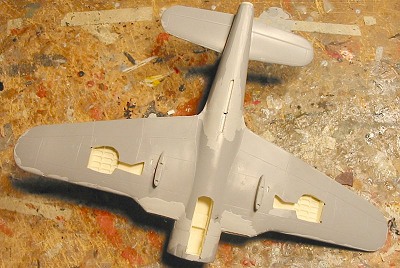 I
ended up using an Aeroclub white metal R-1830 engine, and putting six
more flattened fishweights on the firewall behind it. Success at last,
only just barely. Even with the main gear wheels flattened quite a bit,
the finished model will still tail sit if tapped, and will stay in that
position until I put it back on its nose gear.
I
ended up using an Aeroclub white metal R-1830 engine, and putting six
more flattened fishweights on the firewall behind it. Success at last,
only just barely. Even with the main gear wheels flattened quite a bit,
the finished model will still tail sit if tapped, and will stay in that
position until I put it back on its nose gear.
As with most limited-run kits, I filled all the seams and joints with cyanoacrylate glue, covered with Mr. Surfacer 500 and sanded smooth, with the engraved panel lines restored.
The other big problem with the kit - after the difficulty of obtaining a nose-sit - is the canopy. I don’t know how this happened, but if you cut out the canopy according to the way it is designed, it is too big all the way around - too long, too high and too wide. After scratching my head over this, I looked at the profile drawing and realized that the canopy’s lower line was wrong.
I
then cut away 1/16" of the canopy rim all around, which got it down to
being the right length and width. It then became apparent that the rear
line of the canopy was incorrect, so I eyeballed that and trimmed it to a
more correct shape. Finally, the canopy fit, but only with the use of cyanoacrylate glue all around (thank goodness it was Futured, so there
was no fogging). I then had to use putty to smooth the canop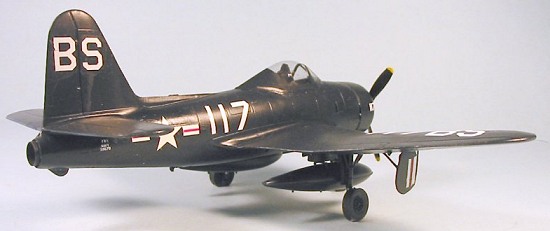 y-fuselage
join, followed with Mr. Surfacer to get it right, then rescribing the
lower line of the canopy with my X-acto. I suppose one could resolve
this problem more easily by posing the canopy open, but the airplane just
doesn’t look as nice in that configuration. With the large bubble
canopy, there’s no problem seeing what’s inside with the canopy closed
up.
y-fuselage
join, followed with Mr. Surfacer to get it right, then rescribing the
lower line of the canopy with my X-acto. I suppose one could resolve
this problem more easily by posing the canopy open, but the airplane just
doesn’t look as nice in that configuration. With the large bubble
canopy, there’s no problem seeing what’s inside with the canopy closed
up.
I also replaced the incorrect drop tanks. Those supplied in the kit are USAAF 75-gallon tanks, which were not used by the Navy. The closest to correct for this type of tank would be to substitute the 58-gallon tanks from the Tamiya Wildcat. Best of all is to use standard US Navy 150-gallon tanks, which is what the airplane carried. I used these from a Hasegawa F4U-5 Corsair kit, including the sway braces, inasmuch as the resin braces used in the kit are too big and one broke anyway.
With these problems solved, the model was ready to be painted once I had assembled and attached the landing gear.
| COLORS & MARKINGS |
Painting:
Painting the model was easy as can be - overall Glossy Sea Blue, including gear wells, doors and landing gear. I used Xtracrylix Glossy Sea Blue, which is the best version of this color I have found. After letting it cure overnight, I gave the model a coat of Xtracrylix Gloss Varnish.
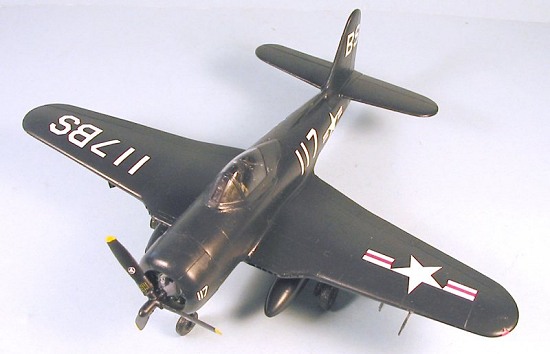 Decals:
Decals:
I went for the VF-1E markings, since they were more colorful. I had a problem here, because the lower wing markings have to go over the open gear doors, and the decals are not sectioned on the sheet. Going by the profile drawing was no help, because the decals were not the same size on the model as the markings were on the drawing. After screwing up the kit decals discovering this problem, I used some other white letters and numbers and national insignia from the decal dungeon and was finally able to get something that looked right. From the photo on the instruction sheet of this airplane, the fuselage insignia and the “BS” letters on the vertical fin were too big, so I replaced these with markings from other decal sheets. (I found the same problem of oversize decals with the FJ-1 Fury kit from this manufacturer, so I was not surprised by this turn of events). The upper wing markings and fuselage numbers were OK.
When the decals had set, I gave the model a coat of Xtracrylix Satin Varnish, which tones things down and gives a “gloss” finish that is much more accurate for a real airplane.
| FINAL CONSTRUCTION |
I attached the prop and the wheels, and painted the jet exhaust. Photos in the mini “In-Action” book that comes with the kit show these airplanes as having been well-maintained, so I did not do any weathering.
| CONCLUSIONS |
The FR-1 is a historically-significant airplane for those fans of early jets and naval aviation. This kit comes together with fewer problems than one finds with many limited-run kits, but it is not for the novice limited-run kit builder. There is a lot of “independent thought” necessary to figure out things like the canopy, the nose-sit problem, and the oversize decals. The result is a very interesting model, and one that is not likely to become available from any other source in the future.
June 2005
If you would like your product reviewed fairly and fairly quickly, please contact the editor or see other details in the Note to Contributors.